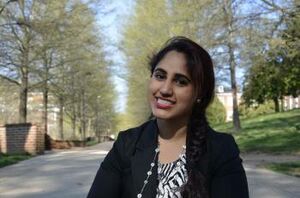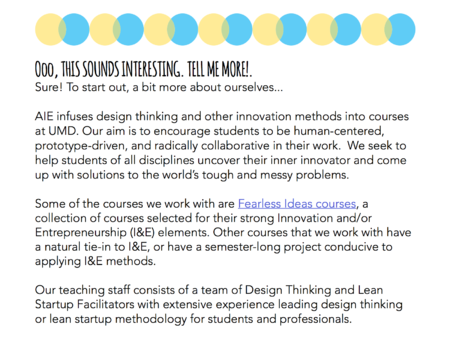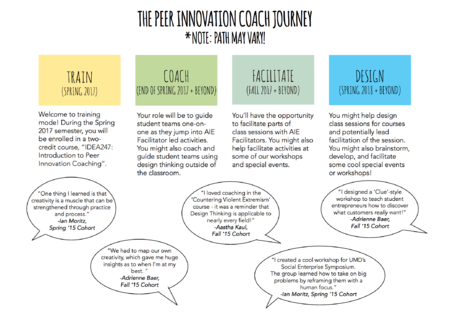Resource:How to Establish Innovation Coaching
Before we start to explain this topic, let’s introduce the fellow who helped start it all...
Meenu Singh began as a University Innovation Fellow in 2014 as a student of Civil Engineering and Philosophy at the University of Maryland. As a fellow, she learned about innovation, entrepreneurship, and design thinking. After her training, Meenu was able to apply these concepts to her own campus when she found that her peers were unable to make their own ideas come to fruition despite their education. By helping her peers, Meenu was able to find passion in innovation coaching, leading her to her current job today, working as an Innovation Specialist at the Academy for Innovation and Entrepreneurship at the University of Maryland. Following, you will find a how to guide on creating an innovation coaching program much like Meenu’s at the University of Maryland.Contents
Why Do We Need Innovation Coaching?
In many cases, students may have great ideas but do not know how to make them happen. Because of this lack of empowerment, Meenu Singh helped create a program at the University of Maryland called innovation coaching to help empower students to make their ideas come to life. By showing students how to be more creative and innovative as well as by connecting them to resources and people that can help them in the classroom, innovation coaches encourage all students’ ideas and essentially become a guide or mentor to show other students that they hold the power in their ideas.
What is Innovation Coaching?
Innovation coaching is a peer-to-peer program that allows students to coach or mentor other students at their university. These coaches help foster innovation in other students by answering any questions students may have, encouraging students in their ideas and projects, connecting students to helpful resources, and being a liaison between students and professors. In addition, innovation coaches may help professors modify course curriculum to allow for more creativity and innovation in classes. Innovation coaches are not TAs, though they work in the classroom much like TAs. Instead of being an aid to professors, innovation coaches are present to help students specifically. They are able to answer questions and translate information from professor to student and vice versa. In many cases, innovation coaches are able to help empower other students to see that they can make their ideas a reality.
How Meenu Did It
In 2013, the University of Maryland took the time to create an innovation center of their own, the Academy for Innovation and Entrepreneurship Center, to benefit their proud Diamondback community. Unfortunately, the students didn’t know what it would be used for and assumed that it was just another building dedicated as a campus incubator or site for seed-funding. Yet fortunately, Meenu was not only a Fellow but a member of UMD’s student government, meaning that she was both tasked with aiding in the designing of the center and was led with her passion for higher education and the need to revolutionize the student curriculum. Her first actions along with 19 other students and a mentor (who specialized in human centered innovation), were to implement the Design Thinking Process.
Design Thinking Process
This is one of the top methods that lead the transformation of ideation into reality - used by many and included in the UIF training, this process is constructed by 3 simple elements of identification, generation and realization.
The first phase is one of pinpointing the opportunities that are in need by the concerned subjects and that can be provided by that which is being designed.
Meenu and her peers attended to her campus, making sure to interview students of all backgrounds, majors and perspectives, questioned what needed to be answered most: What do you feel is missing from campus? What do you think the new innovation center should provide?
What they found was that many students lacked and wished for the opportunity to be creative in their courses and wanted to gain credit for influential projects outside of class, especially those outside majors that were deemed innovative. When asked about what the most surprising element was in regards to this entire process, Meenu stated that “when I asked a peer named Maya, ‘If you had an idea what would you do with it?’ she stated that she would, ‘lament the future nonexistence of that idea’ and I couldn’t believe it. It was the saddest thing to hear such a successful student feel unempowered. To hear from students that didn’t know if I&E was for them was eye opening.” Clearly the problem had been identified; the need for an element that promoted and supported creative thought needed to be formed.
The team immediately took their findings back to the center’s administrative board to implement the second phase: generation of the idea/solution.
Once the problem is defined such information has to be used to then guide the solution. That not only includes designing something that tends to certain necessities but the production of the resources needed to implement the solutions as well.
With UDM’s student government and the center’s administration board having direct access to funding and materials, Meenu’s team presented their findings and initial ideas, highlighting their peers concerns regarding their creative confidence and competence, in order to ultimately collaborate on what their new innovation center could provide and find what was needed in order to do so.
Together they finalized the goal to introduce both innovation and entrepreneurship to UDM’s students by working with faculty to reshape their curriculum. Which would be done by giving their students the ability to take classes that are project based, making sure to transcend any normative book-report-esqueresearch tendencies, by embedding the very same designing thinking process throughout the DNA of their courses. Together, the idea of allowing their students to be mentored by innovative coaches was born.
That collaboration successfully led to the final realization element of the design process. Such a phase is made up of continually producing great prototypes and testing. For the team, that meant putting their resources (money, faculty, departments) to use in producing their idea of restructuring their courses and being able to consistently reflect on their progress. To innovate their innovation!
Having produced UDM’s fourth cohort, Meenu and her team have gone through noticing that students respond better with peers as their coaches than faculty. Carefully determining how the students that were to become peer innovative coaches (or PICs) were to be compensated and figuring out methods of PIC training and key timelines. All by actively being a part of the process and reflecting throughout the PIC experience. Today, Meenu looks forward to expanding the program and “getting PICs integrated more into helping the faculty with forming the projects” in order to aid their on-the-groundperspective.
Now, the University of Maryland has an extremely admirable two-semester-long training that students take in order to understand the design thinking process, take on the mindsets that are conducive to innovation, and see that in order to truly be able to be influential a peer innovation coach must be a coach (an individual who guides and works alongside students) rather than an advisor (an individual that just instructs and solely helps the faculty). The result leads to a vast amount of students gaining creative competence from their peers and now knowing what to do with ideas that could impact their communities and eventually the world!
(Here’s their PIC application!)
Outcomes of the Project
Meenu came to the realization through the program that there were so many students that didn’t believe “entrepreneurship was for them” or that they had any agency of creating change. This appalled her and thus created a goal for the program to empower these students and give them the confidence and preparation they needed to realize their goals and aspirations. She found that many students shifted their mentalities after being involved in that some were able to realize their love for innovation and entrepreneurship. They wanted to ensure that students were the main thinkers and designers on projects, and through these hands on experiences, they could realize their true potentials. Through this program, Meenu has expressed witnessing students, through reading their written reflections, both accomplish their goals and feel this sense of empowerment they need as they learn in their individual ways. Meenu, to this day, continues to work for the Peer Innovation Coaching program and tells us that it continues to adapt as the program grows and they discover the different ways in which people learn best. She advises us all that in our own ventures as UIF trainees that we should definitely be open to listening and learning from each other. With this in mind, we as fellows will be able to make the best out of our experiences and take away beneficial ideas in order to better our own schools through learning from others. She finally reminds us all that peer coaching can be utilized through any project and every school should try it.



